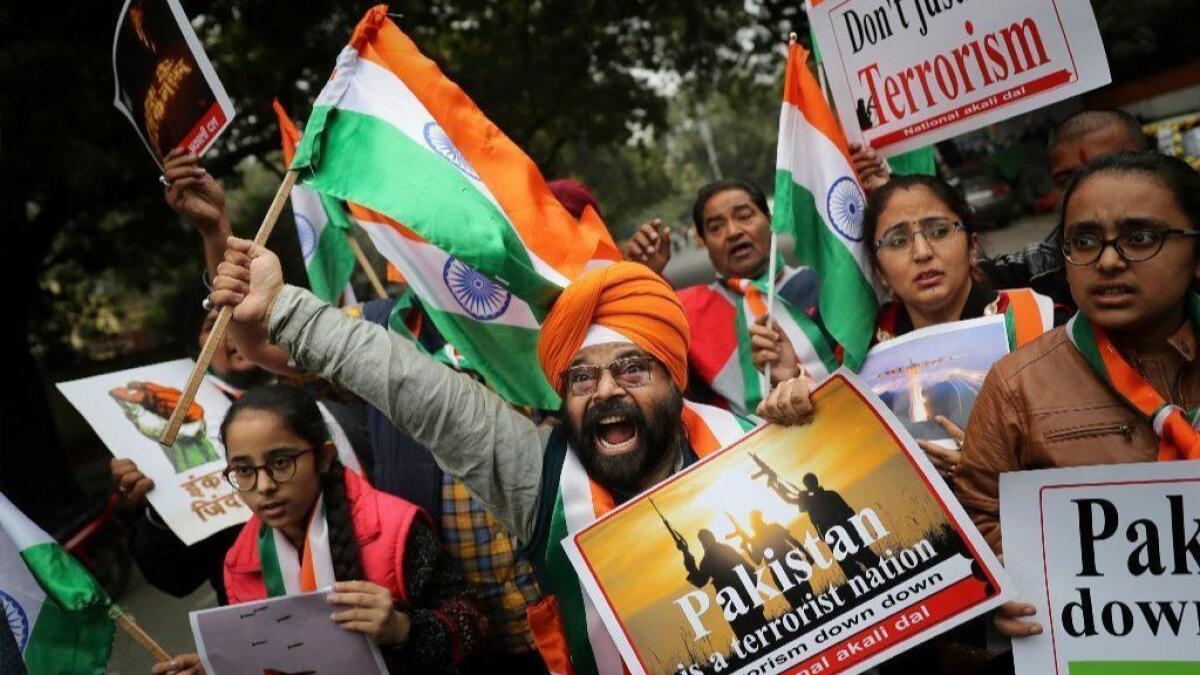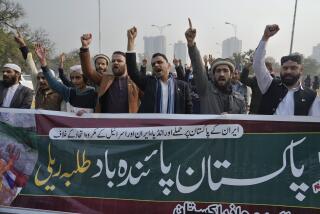Analysis: Why the next round of India-Pakistan hostilities could be even scarier

Reporting from Islamabad, Pakistan — When 35-year-old Indian fighter pilot Abhinandan Varthaman, wearing a sport coat and rakish gunslinger mustache, walked across the heavily armed Pakistani border into India on Friday, it calmed nerves across the subcontinent and beyond.
For three days, India and Pakistan, nuclear-armed rivals that have fought three wars and come close to several more, had engaged in their most serious military dust-up in nearly two decades over the disputed Kashmir territory.
An Indian airstrike aimed at militants deep inside Pakistan, followed by Pakistani forces shooting down Varthaman’s Russian-made MiG jet and capturing him, risked escalating into a full-blown war — a terrifying prospect given that the countries have nearly 300 nuclear warheads aimed at each other.
Varthaman’s release, hailed as a diplomatic victory in India and a magnanimous gesture in Pakistan, was the palliative the crisis needed. Although both countries continue to accuse the other of firing artillery shells across their contested boundary, including on Monday, train service between the two has resumed, schoolchildren in Kashmir are returning to classes and the immediate threat of war has receded.
But analysts say the skirmish points to a changing security dynamic in South Asia, where India appears more willing to take military action against its neighbor, and Pakistan faces growing isolation internationally for failing to rein in militant groups based on its soil.
“I don’t think we’ll be back to business as usual for India,” said Brahma Chellaney, a professor of strategic studies at the Center for Policy Research in New Delhi. “I see this as a potential game-changer.”
It’s possible that in the next confrontation that may be coming, we might see a military conflict rather than tit-for-tat aerial raids.
— Brahma Chellaney, Center for Policy Research
India’s airstrike Tuesday was a response to a Valentine’s Day suicide bombing that killed 40 paramilitary troops inside the Indian-controlled portion of Kashmir. Jaish-e-Muhammad, a terrorist organization that plots and carries out attacks against India from bases in Pakistan, claimed responsibility.
Pakistan’s powerful military and intelligence establishment has long cultivated militant groups that foment chaos in India and Afghanistan. In recent decades, India has typically responded to such attacks with restraint.
In 2008, after Pakistani militants killed 160 civilians in the commercial hub of Mumbai, India did not strike back militarily, wagering that retaliation would embolden Pakistani hard-liners while failing to make a dent in a shadowy and extensive militant network.
The U.S., which was heavily reliant on Pakistan to support its military campaign in Afghanistan, backed India’s diplomatic push that got Lashkar-e-Taiba, the group that claimed responsibility, placed on a State Department blacklist and focused international attention on Pakistan’s ties to militants.
But India continued to be hit by smaller attacks from Pakistan, while Lashkar’s leader, Hafiz Saeed, remained free despite a $10-million U.S. reward being offered for his capture. Over the years, India’s strategic restraint in effect vindicated Pakistan’s strategy of developing nuclear weapons as a deterrent against attacks by its larger neighbor.
Even as New Delhi’s strategic restraint allowed it to focus on building its booming economy while Pakistan’s languished, hawks in India have pushed for a tougher response worthy of an aspiring global power. In 2008, a rising politician at the time, Narendra Modi, said Pakistan needed to be dealt with “in a language it understands.”
Now Modi is India’s prime minister, the head of an ascendant Hindu nationalist party that has sought to seem tougher on Muslim-majority Pakistan. In 2016, following raids on Indian forces at Uri and Pathankot, India launched what it called “surgical strikes” against militant targets a short distance across the border in Pakistan-held Kashmir.
Last week’s airstrike reached beyond the disputed territory and into the Pakistani heartland, hitting an area 60 miles north of the capital, Islamabad — the first publicly acknowledged incursion by Indian warplanes into Pakistan since a 1971 war.
It was an embarrassment for Pakistan, stirring memories of the secret 2011 U.S. raid that killed Osama bin Laden outside Islamabad while escaping detection by Pakistani forces. And it indicated that India’s policy of restraint could be ending.
“Nuclear deterrence works but it doesn’t make limited war impossible,” said Ayesha Siddiqa, a Pakistani author and expert on military affairs. “In the Uri and Pathankot times, what the Pakistani military learned was that India would not respond due to deterrence. In this attack, India has shifted the red line.”
At least two factors are believed to have influenced India’s change in posture. One is an election scheduled for May, in which Modi’s failure to avenge the deaths of Indian soldiers could have cost him at the polls. The cacophonous bloodlust of Indian TV and social media networks may have nudged the government toward decisive action.
The second is the growing isolation of Pakistan. President Trump has withheld hundreds of millions of dollars in security assistance over Pakistan’s failure to rein in militant groups attacking U.S. forces in Afghanistan.
But some analysts say the picture is muddier.
For one thing, the impact of the Indian strike isn’t known. Indian officials have suggested that it hit its target, believed to be training facilities used by Jaish-e-Muhammad; Pakistan claims the strike landed in an uninhabited grove of pine trees.
The next day, Pakistani warplanes attacked Indian jets over Kashmir, and in the dogfight each side claimed to have shot down the other’s aircraft. (The U.S. government has asked Pakistan whether U.S.-made F-16s were used in the incident, a possible violation of trade agreements governing how the aircraft can be used.)
Varthaman’s capture illustrated the risks of military action — and then allowed Pakistani Prime Minister Imran Khan to play statesman, saying the pilot would be released as a “peace gesture.”
“As soon as the pilot was shot down, the Indian side looked as if it had been caught by surprise,” said Happymon Jacob, a security expert and professor at Jawaharlal Nehru University in New Delhi. “This therefore looks more like an action that was undertaken ahead of a general election, and was demanded by political circumstances rather than as the result of military planning.”
While no country criticized the Indian strikes, Jacob said that New Delhi would be wrong to view Pakistan as totally isolated. The Trump administration’s effort to make peace with the Taliban demands Pakistani cooperation in bringing militant leaders to the negotiating table, “and it’s only a matter of time before the Americans will come back to court Pakistan again,” he said.
With anti-Indian sentiment running high in Muslim-majority Kashmir, it is not a question of whether Indian forces will be attacked again, but when. The message sent last week is that India’s response cannot be predicted.
“It’s possible that in the next confrontation that may be coming, we might see a military conflict rather than tit-for-tat aerial raids,” Chellaney said. “It’ll be limited, it’ll be short — maybe a week or less — but that scenario can’t be ruled out.”
Special correspondent Sahi reported from Islamabad and Times staff writer Bengali from Singapore.
More to Read
Sign up for Essential California
The most important California stories and recommendations in your inbox every morning.
You may occasionally receive promotional content from the Los Angeles Times.










